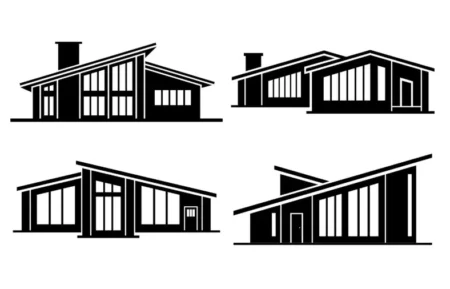 Every house has a personality, and the roof is its expression. It’s what gives a home its character — sharp, smooth, curved, flat. But beyond looks, the shape of a roof decides how well your home breathes, resists storms, and lasts through the years.
Every house has a personality, and the roof is its expression. It’s what gives a home its character — sharp, smooth, curved, flat. But beyond looks, the shape of a roof decides how well your home breathes, resists storms, and lasts through the years.
People often ask, “What’s the best roof shape?” The truth is, there isn’t one universal answer. The “best” roof is the one that fits your environment, your lifestyle, and how you want your home to feel.
The Classic Pitch: Strength in Simplicity
The pitched, triangular roof — also called a gable — is the world’s favorite for a reason.
It sheds water and snow easily, keeps attic spaces dry, and looks timeless. Whether it’s a New England farmhouse or a modern suburban home, a pitched roof signals stability and tradition.
But it’s not just about nostalgia.
That slope reduces the risk of leaks, makes rainwater drainage efficient, and adds natural ventilation under the roof. In places with heavy rain or snow, it’s not just smart design — it’s survival.
The steeper the angle, the better it performs in bad weather. That’s why sharp gables dominate northern climates.
The Hip Roof: Quiet Balance
A hip roof has four sloping sides instead of two, meeting neatly at the top.
It looks calm, balanced, and elegant — but it’s also incredibly practical.
Because all sides slope down, it resists wind better than almost any other shape. That’s why it’s popular in hurricane-prone areas like Florida or the Gulf Coast. The symmetry spreads pressure evenly, keeping the structure stable during strong storms.
It also creates overhangs that naturally shade walls and windows — a built-in energy saver.
The only downside? More slopes mean more seams and materials, which can make it pricier to build and maintain. But for peace of mind, it’s hard to beat.
Flat Roofs: Modern Looks, Smart Function
Flat roofs get a bad reputation, mostly from old designs that leaked easily.
Today, they’ve evolved — with better materials, drainage systems, and insulation.
Architects love them because they look sleek and modern. Homeowners love them because they’re practical: you can turn the roof into a terrace, a garden, or even install solar panels.
They’re ideal in dry or warm climates where rain isn’t a constant threat. But in snowy or rainy regions, flat roofs need regular care. A little neglect can lead to big problems.
So if you love that clean, modern look — plan for maintenance, not miracles.
Curves, Domes, and Green Roofs
Around the world, you’ll find roof shapes that are as much art as engineering.
Curved roofs, like those seen in Asia or contemporary architecture, aren’t just beautiful — they reduce wind resistance and direct rain smoothly.
Domed roofs, used for centuries in hot climates, allow heat to rise and escape naturally, keeping interiors cooler. And now, green roofs — covered in plants — are redefining what a “roof” even means. They insulate the home, absorb rainwater, and create mini ecosystems in urban spaces.
The idea is the same across all designs: a roof should work with nature, not against it.
The Real Secret: Climate + Character
There’s no one perfect roof.
A sloped gable might be unbeatable in snowy Maine, while a flat roof makes perfect sense in sunny Arizona.
What matters most is harmony — between structure, weather, and lifestyle. A well-designed roof doesn’t just protect; it completes the house. It keeps the elements out and comfort in, year after year.
Think of it as the home’s silent guardian — the part that takes all the hits so you don’t have to.
The Bottom Line
The best roof isn’t about trends or aesthetics.
It’s about understanding your environment, your needs, and your future.
Choose a roof that doesn’t just look good, but lives well.
Because in the end, design isn’t about what impresses from the street — it’s about what endures when the weather turns wild.
Picture Credit: Freepik
